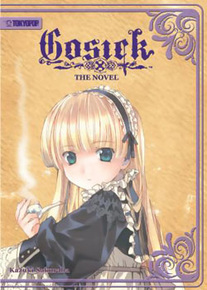Review
by Carlo Santos,Gosick
Vol. 1 (novel)
| Synopsis: |  |
||
Kazuya Kujo is studying abroad in the tiny European kingdom of Sauville in the year 1924, so it's only natural that his foreign background makes him stand out. But one of his fellow classmates stands out even more—Victorique, a doll-like blonde girl who spends her days reading difficult books in the school library and solving mind-boggling crimes with her superior intellect. However, Kazuya and Victorique find themselves caught up in a deadly mystery when they stumble aboard the cruise ship Queen Berry, the subject of a terrible tragedy from 10 years ago and supposedly haunted. Outside the safety of school, on a slowly sinking ship with a mad killer on deck, Victorique and Kazuya will have to rely on all their wits to survive ... and solve the mystery. |
|||
| Review: | |||
Funny-sounding title aside, Gosick is certainly "Gothic" in character, with a violent murder-mystery weaved into an elegant period setting. If you ever wanted a classic example of a closed-room case, few things are as closed-room as a ship lost at sea—all the suspects are on board and there's no getting off the boat! The characters, too, fill in classic archetypes; Victorique plays the Holmes to Kujo's Watson, except that instead of a deerstalker cap, Victorique goes for frilly dresses, adding the Lolita element to the Gothic. With elaborate explanations, clever misdirections, and a story-within-a-story, this period detective thriller has all the right elements—not necessarily a breakthrough, but a fine example of the form. The first thing one notices is the careful establishment of characters and setting. Victorique, of course, is the most distinctive, with her delicate demeanor and sarcastic tongue (can we say tsundere?), but there are plenty of others, like the goofy town detective Grevil and the morally questionable characters on the cursed ship. Amidst all this, Kazuya feels a bit bland, and his ethnic background seems like cheap pandering to the target audience, but he provides the everyman point of view that gives readers a window into the story. The setting, too, is a distinctive one: Sauville comes complete with an imagined history, geography and culture, as seen in little things like architectural details or the way different people carry themselves. And once aboard the boat, the attention to atmosphere and detail are heightened even more with the Ghost Ship's aura. But the real star of the show is the plot, of course, which is paced almost perfectly—the main mystery starts about one-third of the way in after a thorough introduction, culminating in a breathless action sequence, and leaving enough room to explain everything at the end. The only hiccup is in the flashback sequences that always seem to shoehorn themselves in at the wrong moment and take up too much time. Although it all makes sense in the end, the flashbacks still give off a feeling of "Here's a confusing scene written in a different character's voice" throughout the story. What may also be confusing (or perhaps disappointing) is that the story seems to give away the main villain really early on. However, the exact details of the villain's scheme are only revealed in gradual snippets, and that's where the story excels—dropping subtle hints that allow you to figure out bits of the mystery in advance, but never the whole thing. (Admittedly, the whole thing turns out be a rather ridiculous, far-fetched scheme, but it's about the journey, not the destination, right?) A well-balanced writing style helps this story to flow naturally on the page. Gone are the clipped, telegraphic sentences that tend to result from Japanese popular fiction translated into English; instead, we get real paragraphs and sentences, with a good mix of description, dialogue and action to keep the story moving. Since plot is more important than style in this kind of story, the lucid writing makes it easy to focus on the mystery at hand. (However, this doesn't stop a couple of typos from sneaking into the translation.) One other annoying quirk is the tendency to repeat certain details—do we really need to hear about Victorique's pale skin and doll-like features one more time?—but perhaps that repetition works, because the characters definitely stick after while. A handful of illustrations also add flavor to the story, although putting faces to the names can sometimes disrupt the immersive experience of prose fiction. Of course, some characters can get away with being illustrated—Victorique is on the front cover, so you already know what she looks like—but for some of the minor characters, it can be disorienting to imagine them a certain way and then discover a half-chapter later what they really look like. The illustrations are pretty decent overall, but the cartoony style doesn't always fit the tone of the story, especially when it gets serious later on. The first volume of Gosick is a solid mystery-thriller that brings in many elements and gets them right: a period setting, a closed-room scenario, an intricate but compelling plotline, and a tsundere goth-loli girl detective (okay, that one's strictly for the otaku, but anyway). What makes this novel particularly impressive is how it balances beginning (introduce the charaters), middle (dig into the mystery) and end (explain what happened) without getting too bogged down or skimping on details. With memorable characters, a memorable setting, and a clever plot that manages to avoid the contrivances and confusions of other storylines, this deserves just as much acclaim as any of the more popular mystery series out there. |
| Grade: | |||
|
Overall : B
Story : B
Art : C+
+ A mysterious, elegant atmosphere and an intricate plotline make this a thrilling read from start to finish. |
|||
| discuss this in the forum (7 posts) | | |||